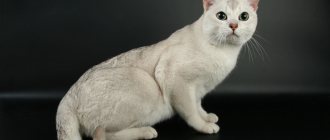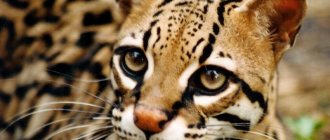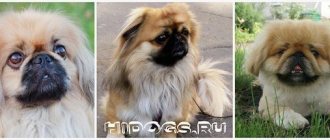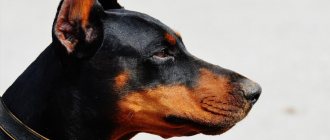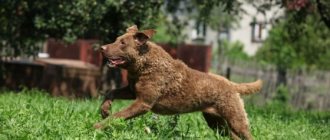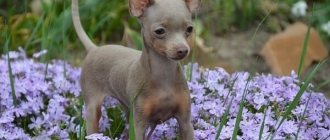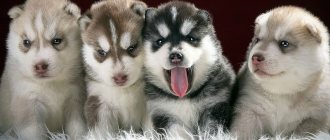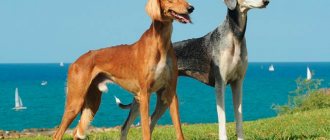History and purpose of the breed
The East Siberian Laika belongs to a large group of breeds, the development of which took place in a limited area. The vast expanses of the Russian North had practically no roads, and the indigenous inhabitants: Evenks and other small nationalities, were engaged in hunting fur-bearing animals, taking local dogs as assistants. Laikas are a common group of primitive breeds that have always lived in Siberia and Alaska. They helped people transport heavy loads and hunt animals, and due to the remoteness of settlements from each other, as well as the inaccessibility of most areas, breed groups multiplied “in themselves.”
Thus, in each region of the North its own special breed of huskies was formed. The East Siberian Laika carries the blood of Evenki and Tunguska dogs, and has always been a true assistant and friend of the hunter. Already in the nineteenth century, this breed was presented at Moscow hunting exhibitions, but a temporary breed standard was adopted only after the Great Patriotic War.
Folk breeding of huskies of this breed was chaotic, did not take into account small details of the exterior, but always aimed to preserve and enhance the hunting qualities of the descendants. The breed became even more interesting for breeders who created nurseries in an effort to study it. The city of Irkutsk became the breeding center in the USSR, where all the best individuals of the East Siberian Laika at that time were concentrated.
Twenty years later, commercial nurseries created by order of the authorities produced huge quantities of furs. In 1980 the breed was recognized by the Fédération Cynologique Internationale, and in 1989 the final breed standard was adopted. But the tragedy of the East Siberian Laika is that with the collapse of the USSR, the nurseries collapsed, most of the dogs were sold to China, and no one particularly looked after the purebred of the remaining individuals. At the beginning of the new century, only about 40 puppies were born in the RKF per year, which is very little for the development of the breed.
After the collapse of the USSR, the breed was practically lost. Today it is rare to meet a real East Siberian Laika; most purebred dogs do not attend exhibitions, but are used only as hunting dogs. The fact that this dog is not a companion and is almost never kept in the city sharply reduces the popularity of the breed.
Origin story
The origin and formation of hunting dogs in the northern taiga zone of Eastern Siberia have not been fully studied. They are probably related to other huskies from the Euro-Asian continent. In their formation, weather conditions and people who destroyed unsuitable individuals played a significant role. The initial basis for factory selection work was the Yakut, Tunguska, Primorye and Baikal offspring of huskies. At the beginning of the 20th century, the Baikal Laika was first described, and it was this description that later formed the basis of the VSL standard.
In 1947, the East Siberian Laika received breed group status. In 1952, a temporary standard was published, and in 1981 the final standard was approved. The East Siberian Laika is also recognized by the Fédération Cynologique Internationale. A significant number of livestock are concentrated in the Smolensk, Leningrad, Irkutsk, Tver, and Moscow regions. The breed is highly valued in Scandinavian countries. Breeding work is carried out with the selection of producers based on working qualities, abilities are determined in field tests.
Usage
Most AFLs have innate hunting qualities. Thanks to this, they begin to work independently; skillfully delivered coaching contributes to the development of the desired talents. The Eastern European husky has a sense of smell and uses smell, hearing and sight in its work. The found animal barks. It follows the trail silently, very viscous. Different dogs exhibit the instinct to grab, strangle and eat prey to varying degrees. When hunting large animals, it is useful, but in the case of furs it leads to damage to the prey. Unlike other huskies, the VSL typically searches at a trot, and at times the dog moves to a walk or gallop. Works independently, without constant guidance and control of the hunter. She is smart, has a well-developed sense of smell, an approximate reaction, and monitors the owner’s movements. Constantly calling the dog reduces work efficiency. Can work on birds and even fetch from the water.
In the traditional habitats of East Siberian huskies, more than 30 species of animals and birds are hunted. The most important species are squirrel, sable, fox, muskrat, bear, and seal.
In some areas, hunters also use huskies to transport their equipment and prey. Those who live along the banks of rivers often train their dogs to work in a harness while the boat is sailing against the current. At the same time, the husky avoids, and sometimes even swims around, obstacles so as not to tangle the line. On the eastern and northern coasts of Lake Baikal, dogs are used in households to transport water and firewood. According to hunters, this adversely affects working qualities, so really good working dogs are not harnessed.
Appearance Features
Representatives in terms of weight and height are included in the category of medium breeds. The average height of males is from fifty-five to sixty-four centimeters; for females these values range from fifty-one to sixty centimeters. The dogs weigh from eighteen to twenty-three kilograms.
East Siberian huskies have a strong build with well-developed muscles and bones. They have a wide chest and a straight back. The tail is long, curled up on the dog’s hip or hanging over the back in the shape of a sickle. In a straightened state, according to standard breed standards, the tail should reach the level of the hock joint; deviations from the criterion by two centimeters are allowed.
The head has a wide skull. The shape of the muzzle is close to wedge-shaped, with a scissor bite. The ears are located at eye level and have the shape of a triangle with equal sides. The ends of the ears are most often rounded, although you can find representatives of this breed with pointed tips of the ears.
The fur of East Siberian huskies is quite long, thick with a well-formed undercoat, which maintains the dog's body temperature, protecting its body from strong temperature changes. In the neck area, the animal's hair is longer and thicker; it creates a so-called collar, which gives the dog a characteristic appearance. Males have a scruff at the withers. Animals shed at least twice a year.
Health
East Siberian huskies are distinguished by good health. The average life expectancy is 10-12 years, but there have been cases of longevity. Many dogs, with proper care and proper exercise, can live 14-15 years, remaining in excellent working shape.
Diseases
Laikas are not susceptible to genetic pathologies. But they are characterized by diseases associated with hunting activities:
- Leptospirosis. While walking or while hunting, a dog can eat a mouse and become infected with this disease. Or be bitten by a marten or weasel, which can also cause infection.
- Esophageal worms. While hunting, the East Siberian husky can catch and swallow a small rodent suffering from this infection. And thus she becomes infected.
- Snake bites. The viper is the enemy of huskies. Often the dog strives to enter into a fight with a dangerous opponent. A snake bite to the neck area is especially dangerous. The owner must have anti-snake serum with him. This will help save your pet from death.
Vaccinations
A healthy dog is the owner's concern. Carrying out routine mandatory vaccinations will protect your pet from dangerous fatal diseases, one of which is rabies. Owners of huskies are advised not to miss vaccination dates, as the dog is especially susceptible to diseases when in contact with wild animals. Before vaccinations, a number of preparatory measures must be taken:
- Expulsion of worms. Almost all puppies are infected with worms. Two weeks before the expected vaccination, dogs are given anthelmintics.
- Flea and tick treatment.
- A visit to a veterinarian who will give an opinion on your health status.
If at the time of vaccination the pet is not feeling well, is lethargic, has poor appetite, or has digestive problems, the vaccination is not given until complete recovery.
Complex vaccines allow you to simultaneously vaccinate your dog against a number of diseases. The Nobivak vaccine has proven itself well. The veterinarian selects an individual immunization schedule.
The standard schedule is:
- The first vaccination is at the age of 8-10 weeks. The dog is vaccinated against diseases such as canine distemper, adenovirus infection, parvovirus, parainfluenza.
- After 2 weeks, revaccination is performed.
- The third is after a complete change of teeth, usually at 6 months. The same vaccine is administered as at 8-10 weeks, plus anti-rabies serum is added.
- The next vaccination is at the age of 12 months. All previous vaccinations are completed.
Then the dog is vaccinated once a year for the rest of its life.
How does the East Siberian Laika differ from the West Siberian Laika?
The variety of husky breeds and small breed differences between them often lead to controversy. So how does the East Siberian Laika differ from the West Siberian Laika? Is there a big difference in the exterior and character of the two Laikas?
The difference between the East Siberian Laika and the West Siberian is its color.
- The most striking difference by which a dog can be accurately identified as belonging to a particular breed is color. The East Siberian Laika is famous for its elegant caramel color, otherwise called black and tan. Dogs of this breed can also be black. In West Siberian Laikas, black or black and tan colors are unacceptable and are a defect in the exterior.
- Dimensions. Easterners should be larger than Westerners; the difference in height at the withers is approximately three centimeters. Accordingly, the East Siberian Laika has a larger head, more powerful bones, and a stretched body format. The West Siberian Laika is sleeker and smaller, its format is close to a square.
- Physical data. Endurance is one of the advantages of Orientals; these huskies can pull a team, tow a skier, or chase an animal. Westerners are not harnessed to sleds, but they are also tireless in pursuit of the beast.
- Ear shape. The pointed tips of the ears of the ZS Laika are a mandatory breed characteristic, while the ends of the ears of the BC Laika may be rounded.
- Character. The East Siberian Laika is considered to be softer in character, compliant and shows almost no aggression towards humans. She is not inclined to dominate, while the West Siberian often shows character.
Description of the breed
According to the FCI standard, the East Siberian Laika (VSL) belongs to the 5th group (“Spitz and primitive types of dogs”), the 2nd section (“Northern hunting dogs”). The standard has No. 305 in the latest edition dated 03/02/2011.
External signs of VSL
The East Siberian Laika is a medium-sized, compact, muscular dog. Males are more powerful than females, which is noticeable visually. A purebred individual must meet the following standard requirements:
- The head is large, wedge-shaped. From above it looks like an equilateral triangle. The skull is wide, especially in males. The stop is smooth and moderately expressed. The occipital protuberance is clearly visible.
- The nose is black. A brown tint is acceptable in white or fawn dogs.
- The teeth are large and strong. Full dental formula (42 teeth), scissor bite.
- The eyes are medium-sized, almond-shaped, slightly slanted, with a trusting and friendly expression. Color brown or dark brown.
- The ears are erect, V-shaped, with pointed or rounded tips. The inner part is well furred.
- The tail is curled into a ring or sickle and held above the back. It is allowed that it does not touch the back or is half-lowered. When extended, it almost reaches the hock joints.
- Limbs straight and parallel. The paws are rounded, the toes are in a ball.
- Movement is free, with strong drive from the hind legs.
- The outer hair is thick, straight, and hard. Short on the head and ears. It forms a collar on the shoulders, and sideburns behind the cheekbones. Males have longer hair at the withers. The undercoat is thick and soft.
- Colors: black with red tan (karamy);
- black;
- black and white;
- grey;
- ginger;
- brown;
- zonal;
- pale yellow;
- white;
- spotted of the same colors.
- males - 57–64 cm;
The East Siberian Laika is a strong and very active dog.
Working trials are required for this breed.
Character of East Siberian Laikas
East Siberian Laikas are hardy and courageous dogs. Among other huskies they have a calmer temperament. They have excellent hearing and excellent sense of smell. The East Siberian Laika has a hunting passion, which is especially expressed in baiting large animals. During work he behaves independently. He gets a lot of positive emotions from hunting, lives it and only here shows all his unique qualities.
These are loyal dogs. They are trusting towards people and kind to all family members. These dogs get along well with other canine pets and get along well with children, patiently enduring all their pranks. True, for this you need to educate and socialize your pet from a very early age (from 1–1.5 months). But no matter how a puppy is raised, other domestic animals will always be perceived as prey, so there will be no peace for either cats or rodents.
The AFL are vigilant and wary of strangers. They do not have innate aggression towards people, so they will not use their teeth. But they will certainly growl menacingly, raising the hair on the back of their heads, which makes them good watchmen.
Disadvantages, defects and disqualifying characteristics
Any deviation from the requirements of the standard is considered a defect. Its influence on the assessment of an individual is based on the severity of the defect and the dog’s ability to do the job.
The actual disadvantages include:
- insufficiently expressed sexual dimorphism;
- convex forehead, somewhat narrowed muzzle;
- partial depigmentation of the nose, lips and eyelids;
- lack of teeth - absence of no more than 4 premolars (from PM1 and PM2 in any combination);
- straight bite after 6 years;
- small, sparse teeth;
- light or amber eye color in black dogs;
- ears - large, low-set, soft, not sufficiently grown inside;
- the back is weak (soft), slightly humped;
- paws turned inward or outward (marked), clubfoot;
- flat or loose paws (not in a ball), insufficiently developed hair between the toes;
- dewclaws on the hind legs;
- slightly constrained movements;
- specks to match the main color on the body or head (on the paws are allowed).
The defects of the breed include:
- anger towards people;
- significant obesity or thinness;
- short or narrow muzzle;
- a strongly smoothed or pronounced transition from the forehead to the muzzle;
- absence of more than 4 premolars, including PM1 and PM;
- round, bulging eyes;
- the ears are excessively large with round tops and a wide base;
- square format;
- excessively extended format;
- light frame;
- heavy, unstable movements or ambling;
- wrinkled, loose skin;
- significantly elongated hair on the back of the front legs, pronounced dewlap on the hind legs and tail;
- wavy, curly, soft or too long coat;
- the specks on the body do not match the main color;
- deviation from standard height by more than 2 cm.
The reasons for disqualification of an individual are:
- aggressiveness or cowardice;
- malocclusion;
- misalignment of the jaws;
- 4 or more missing teeth, including PM1 and PM2 or M3, extra incisors;
- clouding of the cornea, eye color interspersed with a different color;
- hanging, semi-erect ears;
- short tail;
- short-haired or long-haired;
- lack of undercoat;
- color: genetic brown;
- genetic blue;
- brindle;
- albinism.
Video: born hunter - East Siberian Laika
Character and hunting qualities
East Siberian Laikas are true Russian hunting dogs with a highly developed orientation reflex. This feature means that they easily adapt to the environment during their growth period. That is, despite the fact that these dogs were bred in the north, they can easily adapt to a different climate without compromising their health.
Owners of East Siberian Laikas note such qualities in their pets as agility, agility, stamina, and masculinity. They love movement and show their best qualities during hunting, a craving for which is in their blood.
In many ways, this breed is universal for hunting. It can be tested to work on different animals, especially the East Siberian Laika has a tendency to hunt sable, ungulates, lynx and bear. Masculinity, endurance, physical strength, lightning speed of reaction make this breed an indispensable assistant for a hunter.
Although malice towards humans and aggressiveness are not typical, the East Siberian Laika can also be used as a watchman, who will notify the appearance of strangers with a loud bark.
Wool and color of the East Siberian Laika
The thick coat of representatives of this breed is slightly longer than that of the West Siberian Laika, therefore the collar that forms on the neck is also more pronounced.
Photo 1. East Siberian huskies have thick fur, designed for the most severe frosts
Male East Siberian Laikas have longer hair on the back of their heads, which can result in a noticeable scruff.
The approved standard for the East Siberian Laika allows for a very wide range of colors for these dogs. They can be black, black and white, black with a piebald shade of gray, red with white accents, or brown.
Health of the East Siberian Laika
Laikas are strong dogs. Their immune system was formed through selection under harsh natural conditions. As such, no genetic diseases have been identified in the breed. Breeders note that on average, working East Siberian huskies live from twelve to seventeen years, which is a very long time for this breed.
The biggest problem of all hunting dogs is a lot of injuries. These huskies have a very dangerous job. When a dog is excited, he often stops noticing many things and even ignores them. For example, when working with a boar or a bear, males behave more fiercely and aggressively, but females are smarter and more careful.
Therefore, a larger percentage of male dogs receive serious wounds from animals. If your dog is injured, it should be carefully bandaged with an bactericidal bandage and placed on a blanket. After placing the dog in transport, you must urgently call the veterinarian and describe the symptoms. Often the owner is in a panic and does not know what to do. Before delivering your pet to the clinic, the doctor can consult him by phone. Laikas need vaccinations and antiparasitic procedures.
Rice. 17. Northeastern sled dog
The constitution is strong - rough. The type of higher nervous activity is balanced - calm. Height at the withers: in males no less than 60 cm, in females no less than 58 cm, height at the rump is 1–2 cm less. Stretching index 108–110. The gait is a low creeping trot and gallop.
The bones are massive and well developed. The muscles are massive and dense. The skin is thick, elastic, without folds.
The coat is thick, coarse, and protects the dog well in harsh arctic conditions. The undercoat is long and dense. The integumentary hair stands out sharply on the neck, along the ridge, on the shoulders and hips. There are dogs with softer and longer hair. Long and hard hair also grows on the paws, between the toes, protecting the toe pads from direct contact with the snow.
The color is varied: black, white, gray, brown, piebald and spotted of the same colors.
Head with a wide and massive skull. The forehead is flat, with a small but noticeable transition to the muzzle.
The muzzle is short, massive, wide at the base, pointed. Lips tightly fitting. The nose is black or brown. The ears are erect, not set very high, relatively short, wide at the base, with blunt tips. The eyes are small, oval-shaped, obliquely set, dark. The teeth are large, scissor bite.
The neck is short, massive, normally set.
The chest is deep, wide, long, with slightly convex ribs. The withers are strongly developed, protruding sharply above the line of the back. The back is wide, straight, strong. The loin is short, wide, muscular and slightly convex. The croup is wide, muscular, relatively short, almost horizontally set. The abdomen is moderately tucked.
The forelimbs are characterized by an elongated scapula and somewhat shortened humerus and forearms. The angles of the glenohumeral joints approach 100°. Forearms are straight, parallel. The wrists are wide and strong. The pasterns are massive, set obliquely.
We suggest you read: What kind of likes are there?
The hind legs (when viewed from behind) are straight and parallel. The thighs are long and strongly muscled. The lower legs are short and strong. The hock joints are wide, fairly straight, and are at the same level as the ischial tuberosities. The hocks are massive, set almost vertically.
The paws are large, compressed into a ball. Dewclaws should be removed from puppies.
The length of the tail reaches the hock joint, sometimes a little shorter. The shape of the tail is sickle, log and ring. In some areas, it is customary to trim the tails of dogs of this breed.
Collie, or Scottish Sheepdog (Fig. 18). The collie is a typical representative of a group of European shepherd dogs that have been cultivated for centuries not to protect herds from predators, but for herding.
Sled dogs in Russia are common in the Lower Amur basin, Sakhalin, on the coast of the Sea of Okhotsk, Kamchatka, along the entire coast of the Bering Sea, in Yakutia, on the Chukotka Peninsula, in the lower reaches of the Taza and Yenisei rivers.
The constitution is strong - rough. Height at the withers: for males - at least 60 cm, for females - at least 58 cm; the height at the sacrum is 1–2 cm less. Stretching index 108–110.
The type of behavior is balanced - calm. Typical gaits are short trot and gallop.
The coat is thick, coarse, and protects the dog well in harsh arctic conditions. The undercoat is long and dense. The integumentary hair stands out sharply on the neck, along the ridge, on the shoulders and hips. There are dogs with softer and longer hair. Long and hard hair also grows on the paws, between the toes, protecting their pads from direct contact with the snow.
The bones are massive and well developed. The muscles are massive and dense. The skin is thick, elastic, without folds. Head with a wide and massive skull. The forehead is flat, with a small but noticeable transition to the muzzle. The muzzle is short, massive, wide at the base, pointed. Lips tightly fitting.
The nose is black or brown. The ears are erect, relatively short, wide at the base, with blunt ends.
The eyes are small, oval-shaped, obliquely set, dark. The teeth are large, scissor bite. The neck is short and massive. The chest is deep, wide, long, with slightly convex ribs. The withers are strongly developed, protruding sharply above the line of the back. The back is wide, straight, strong.
The loin is short, wide, muscular, slightly convex. The croup is wide, muscular, relatively short, almost horizontally set. The belly is moderately tucked.
The forelimbs are characterized by an elongated scapula and somewhat shortened humerus and forearms.
The angles of the humeroscapular joints are 100°. Forearms are straight, parallel. The wrists are wide and strong. The pasterns are massive, set obliquely. The hind legs (when viewed from behind) are straight and parallel. The thighs are long and muscular. The lower legs are short and strong. The hock joints are wide, set straight, at the same level as the ischial tuberosities. The hocks are massive, set almost vertically. The paws are large, compressed into a ball. Dewclaws should be removed from puppies.
The length of the tail reaches the hock joint, sometimes a little shorter. The shape of the tail is “sickle”, “log” and “ring”. In some areas, it is customary for dogs of this breed to have their tails trimmed.
How to properly care for the East Siberian Laika?
If the dog is in an enclosure, then caring for it will not be very difficult.
But in apartment conditions everything will be more complicated, since there are a number of factors :
- such a dog really needs movement and space;
- There is intense shedding, so the thick undercoat will remain on the carpets.
It is not recommended to have a pet of this breed in the following cases:
- if you are accustomed to a measured and calm lifestyle;
- if you spend a lot of time outside the home;
- do not like hunting and active recreation.
Even if you are not a hunter, but simply love activity and are ready to walk with your pet for a long time, you can safely get such a husky.
Many people believe that such a dog will act as a stern guard. But in reality this is not the case, since they are mostly indifferent to strangers, and in some cases even sympathize with them.
Representatives of this breed are generally in good health and do not suffer from hereditary diseases. Moreover, such a dog, compared to other decorative and service species, can digest food better and eats as much as it needs. This feature is very useful, especially in extreme situations, in particular during long hunting trips with a dog. At other times, the animal must be fed according to the usual schedule - twice a day for an adult. A distinctive feature of the breed is that it is not picky in terms of nutrition, which is very good for the owner.
Content Features
Maintaining an East Siberian Laika is not burdensome and will not require large expenses. Living next to a smart and obedient dog is easy. The best option for a hunting husky is to live in an enclosure with a warm booth and the opportunity to spend a lot of time moving in the open or running freely around the area. Keeping a husky in an apartment is possible, but the owner will have to devote much more time to the quantity and quality of walks so that the dog does not lose those innate qualities that are important when hunting.
Care
The East Siberian Laika does not require complex care. It is enough to brush your dog periodically to maintain a neat appearance. Somewhat more often during seasonal molting. VSL sheds quite profusely. Bathing is indicated as needed. Owners also need to keep their eyes, ears and claw length clean.
Optimal diet
The East Siberian Laika eats little. The number of meals should be appropriate for their age. Puppies are fed 4-5 times a day, adult dogs 2 times. Make sure that your dog does not overeat, this leads to disruption of the digestive system and can even lead to obesity. The main product in the diet should be meat. Beef, veal, and poultry are suitable. It is better to serve meat boiled. Be sure to include fish in your diet.
Don't forget about vegetables as a valuable source of vitamins and minerals. It is better to give them in crushed form and add to meat. At the same time, your pet will receive more vitamins if the vegetables are raw. It is also very useful to give your dog fermented milk products (cottage cheese, sour cream, kefir) to strengthen the skeletal system.
To strengthen the teeth, the dog is given bones and tendons. This way, your pet will happily satisfy its need to chew and receive a supply of salts and minerals. It is better to boil the bones; in their raw form they are poorly digestible. You definitely need to buy vitamins for dogs; taking them will help replenish all the missing elements. Also, make sure that there is always clean drinking water near your food bowl.
It is strictly forbidden to feed:
- confectionery products;
- smoked meats;
- spices, seasonings.
Small puppies up to 4 months of age need exclusively milk and first complementary foods; they are not given fermented milk products. It is not advisable to feed these dogs dry food; it is unnatural for their natural habitat. Dry food can be used as a reward.
Maintenance and care
The East Siberian Laika is a dog with strong immunity and hardening developed at the genetic level, so experts recommend not taking even newborn puppies with their mother into a warm place, but keeping them in an unheated room. You can often hear stories about how easily Easterners adapt to apartment life. At the same time, keeping the breed in “greenhouse” conditions is not approved by breeders, and it does not benefit the animal itself. A healthy working dog is able to live in the yard, where a durable enclosure with a warm booth should be built for it, which is best installed on the sunny side.
Keeping a husky on a chain is acceptable as a temporary phenomenon until the enclosure is equipped. Moreover, the chain must be attached to a movable block, which will allow the animal to move freely around the yard. You need to take your puppy for a walk in crowded places after vaccination against distemper and enteritis. Before receiving vaccinations, it is also necessary to take the baby out to breathe, but in locations where contact with other dogs and people will be excluded. It is best to walk with your ward in forests and meadows, which is preparation for future hunting. The duration of promenades should be at least 2 hours a day, since the longer the puppy is in the sun, the less chance he has of getting rickets.
Hygiene
East Siberian husky puppies cannot be bathed at all. Adults should also not be washed unnecessarily, since the protective fatty lubricant is removed from the skin and coat along with shampoo and water. It is enough to wipe a dirty pet with a damp cloth, and rinse dirty paws in lukewarm water without using dog cosmetics. It is strongly not recommended to wash the East Siberian Laika on the eve of the exhibition, since the hair devoid of the fat layer looks less aesthetically pleasing and there is a risk of receiving a low score from the judges for exterior.
You need to brush your yard VFL twice a week during the shedding period and once a week at all other times. With apartment huskies, the frequency of brushing will have to be increased if you do not want the home to turn into a warehouse for wool. If the dog hunts constantly and productively, the “pedicure” of the claws can be neglected, since the plate is naturally worn down. Orientals, who travel to exhibitions more often than work, need to have their nails carefully trimmed. The East Siberian Laika's ears are checked after each trip to the forest or a couple of times a week if the dog spends time in the yard.
It is better to remove excess wax inside the ear specula with a cloth soaked in hygienic lotion. Mandatory measures include treating the fur against ticks and ectoparasites, as well as periodically boiling the mattress on which the animal sleeps. It is extremely important to monitor the health of the East Siberian Laika’s eyes and remove dirt from them with a clean cloth moistened with strong, chilled tea. If your eyes suddenly become red or watery, try applying tetracycline ointment to the lower eyelid. If there is no improvement within a couple of days, the husky will have to be taken to the veterinarian.
Feeding
Adults are fed twice a day, and during the hunting season the food is divided into unequal parts: in the morning the pet eats ⅓ of the daily requirement, in the evening, but not earlier than an hour after working on the animal, the remaining ⅔. As for any hunting dog, the basis of the diet for the East Siberian Laika is meat. In order to save money, everything obtained during the hunt is used - cut up squirrel carcasses, muskrat meat and entrails, as well as any other edible trophies. During active fishing activities, the share of animal food in the daily menu of the AFL should reach 600-800 g.
East Siberian huskies are unpretentious pets that do not need food variety. Along with meat, they can also be given cheaper products - sea fish, from which large bones have been extracted (can be minced), cereal porridges, offal, rye bread, curdled milk, chicken eggs, vegetables (except legumes), fruits, young greens. Some owners teach their pets to find edible fruits and eat them from the bush. In the future, if the dog gets lost while hunting, it will be able to feed itself for several days.
Mandatory products in the diet of East Siberian husky puppies are cottage cheese and cartilage tissue, without which the formation of a strong skeleton is impossible. The first complementary food in the life of an Easterner is liquid porridge with milk (semolina, pureed rolled oats). They are best given to one-month-old puppies. Six-month-old adolescents are allowed to include porridge from whole grains in the menu - rice, oatmeal, pearl barley. They are prepared in meat and bone broth with the addition of a small amount of salt, unrefined vegetable oil or fish oil, as well as vegetables - cabbage, carrots, pumpkin, zucchini. It is also useful to feed the growing VFL with sprouted oats and wheat. Unsalted cheese, butter, and rye crackers are suitable as an incentive treat. The source of the necessary vitamins can be dandelion leaves, nettle (scalded with boiling water), kelp or ready-made vitamin complexes from a veterinary pharmacy.
Important: East Siberian huskies are only allowed to be given river fish and liver that have been heat-treated, since these products are often contaminated with worms.
Education and training
You shouldn’t delay raising your four-legged friend; you should start immediately as soon as he gets into the house. Otherwise, the owners will soon be faced with the pet’s stubbornness, self-will and independence.
Laikas are prone to escape, they do it so masterfully that the owner can wonder for a long time how this happened. They can make tunnels, climb over high fences and free themselves from the collar.
It is recommended that you take your pet through special obedience courses for up to six months. Thanks to competent training, the puppy will quickly begin to perceive the owner as a leader, become attached to him and will be more willing to obey.
Joint training and training will help the owner find a common language with the pet, understand the needs and mood of his four-legged companion, which is very important not only for normal life, but also for hunting. Traditionally, hunting dogs have only one owner. It is he who is responsible for the main concerns about the pet - feeding, walking, training. The dog must hunt with the same person.
Training of huskies begins at 6 months of age, initially using special areas for this. It is advisable if an adult dog who has been trained and has some experience works in tandem with a newly minted hunter. Laikas are excellent imitators and can adopt knowledge and skills from their brothers.
How to choose the right puppy?
Although dogs of this breed have certain similar qualities, they may have different inclinations and abilities. So, for some dogs, hunting can be a favorite and exciting activity, while others can be mediocre or very weak hunters. Puppies should be active and healthy. It is not necessary to choose the largest of the litter; this is not the main quality. The main thing is intelligence. If you doubt that you can choose the right puppy, invite an experienced hunter with you. It should also be taken into account that if you choose a girl, the hunt will be postponed during the periods of estrus and nursing the puppies.
The price of puppies varies depending on the availability of pedigree. It should be taken into account that purebred dogs are rare, these huskies are not very common and their cost is quite high. So, the price can start from $300. But such dogs must have an impeccable pedigree.
Puppies are also sold at a more reasonable price. So, the price may be less than a hundred dollars, but then you will not have a guarantee that it is an East Siberian Laika, the description of which is similar to other breeds.
If the purpose of the purchase is hunting, you can purchase an adult dog of this breed. The price of such pets is naturally much higher, but they will undoubtedly show their worth in business. Huskies are sold with a “narrow” focus: hunting large game, squirrels or sables. The seller may also have a video showing the dog in action.
Choosing an East Siberian Laika puppy
Experienced barkers can tell something about a dog’s character from a very early age, but its working qualities will be revealed much later and depend on heredity. Therefore, first of all, you should choose a puppy based on its parents. Of course, the further education of the dog and the amount of time spent with it in the forest play an important role, but you can’t do without the makings.
In just two or three generations, the hunting qualities will deteriorate and the dog will be unsuitable for work. If parents, and especially grandparents, only went to shows, you can’t expect anything from the puppies.
The East Siberian Laika is much inferior in popularity to the same Russian-European or West Siberian Laika. However, finding a kennel or breeder is not a problem, as are puppies available for sale.
The weight of the husky as a puppy varies greatly. One month old puppies weigh about 5 kg. At 2 months, some can weigh 6 kg, others - 8 kg. When choosing a puppy, they look not so much at its size (the largest dog is not always the most efficient), but at its vitality: the ability to quickly make its way to the mother’s nipple, activity in an unfamiliar environment, leadership qualities that are manifested in playing with littermates.
Price
The price of an East Siberian husky puppy varies greatly depending on geography, the merits of the parents and many other factors. In nurseries, puppies usually cost 25,000-35,000 rubles. For private breeders, 5,000-15,000 rubles. An adult working husky can cost 60,000 rubles. and more expensive.
Price of the East Siberian Laika
The purebred East Siberian Laika is currently not a popular or very common breed, so it is not too easy to acquire a true breed representative.
As a rule, for this purpose, information about planned matings is monitored in advance and regularly on the websites of well-established nurseries. It is also advisable to attend exhibitions and hunting dog competitions, where you have the opportunity to directly meet the breeders of the East Siberian Laika.
The minimum cost of such a puppy is 25 thousand rubles, but the most promising pets are sold for much more . When purchasing an adult dog, all its main characteristics and work achievements must be taken into account. It should be noted that East Siberian huskies, which work in hunting large animals, cost approximately three times more than the so-called “squirrel cats” and “sable cats”.
Historical data, emergence of an official standard
The history of the origin and formation of the breed dates back several thousand years.
The ancestors of the East Siberian Laika lived in the vast expanses of Siberia and the Urals. The peoples living in these territories selected dogs not only for their appearance, but also for their abilities. Since hunting was their main occupation, the hunting talents of animals were especially valued. At the end of the 19th century, there were at least 10 groups of dogs called huskies in northeastern Europe. Their first exhibition was organized in Moscow in 1874. Not all groups of dogs were given breed status and officially recognized in Russia and the world. The East Siberian Laika is an exception in this regard.
Descriptions of varieties of huskies were mentioned in the works of Prince A. Shirinsky-Shakhmatov and game warden Abramov. In 1949, a temporary standard of 4 breeds of huskies was adopted. Active breeding began in the 60-70s, with Leningrad and Irkutsk becoming the center. Dogs bred in these cities, in addition to common features, also have some differences: Leningrad dogs are slimmer and more refined, and have a pointed muzzle. Differences can be seen by looking at photos of two types of dogs.
The formal breed standard was adopted in 1980, at which time the East Siberian Laika received international status.
But to this day, dogs of this breed have not been fully studied; they appear at exhibitions in small groups. Puppies of this breed are not often officially registered. In general, in 2000, less than 40 dogs were officially registered in Russia.
Owner reviews of the East Siberian Laika
Michael
These are natural hunters, universal dogs, they work on any animal - even a pheasant, even a bear! They are not afraid of anything. But I am against such dogs living in an apartment - they are free animals who love to work.
Nikolai
This is a dog that is characterized by independence and perseverance. She will go without hesitation even towards a bear. Easy to learn. Puppies are expensive, but they are worth it - my husband is a hunter, I know what I’m saying.
Lera
No matter what they say, VSL lives in our apartment and feels great. Her husband goes hunting with her and always returns with prey. The dog gets along well with children and is very smart - he never even pulls on the leash outside.
Sofia
My review of the East Siberian Laika will be only positive. The dog easily gets along with a large family and treats children with special reverence, but there will only be one owner. Education will fall on the shoulders of the head of the family. These dogs will not get along with cats, hamsters, parrots and you should not insist. If you already have a cat living in your house, with the right approach, the animals can be accustomed to each other.
Ivan
East Siberian huskies do not require special care, but if you decide to have a dog in an apartment, you need to take into account that there will be a lot of hair. When spring comes, animals will shed all their fur; dogs shed especially intensely. In winter, do not touch the fur, except perhaps comb it with a sparse comb. In the summer, regularly examine your skin for dermatitis and parasites. Preventive treatment for fleas, ticks and worms is a very important aspect of caring for any animal. With the curiosity inherent in Laikas, your pet will definitely examine all the bushes, holes and holes, and quite rare species of parasites can live in such shelters.

